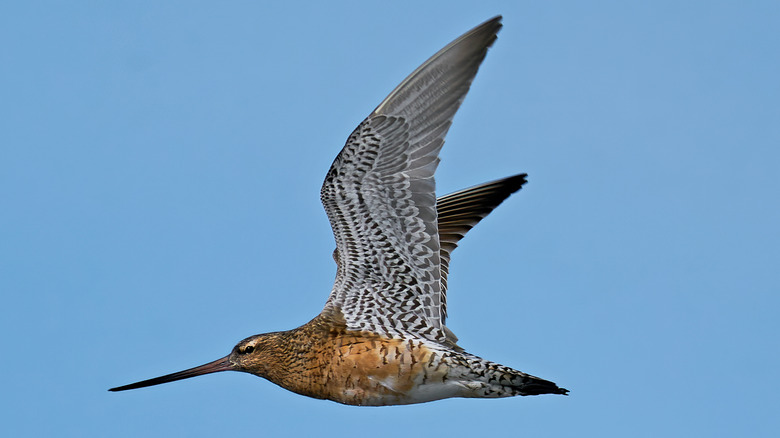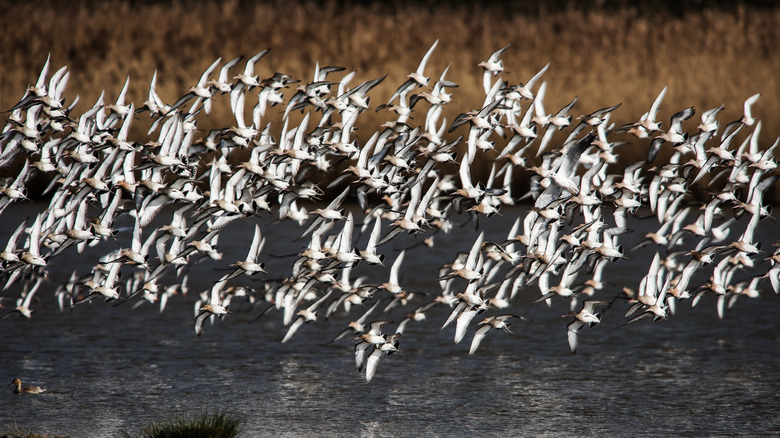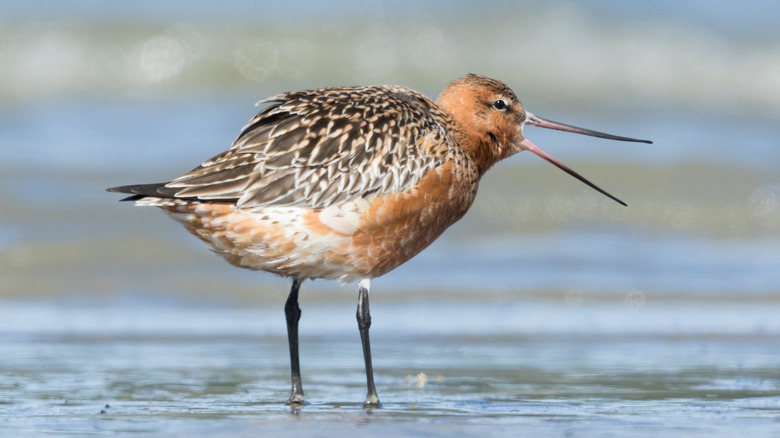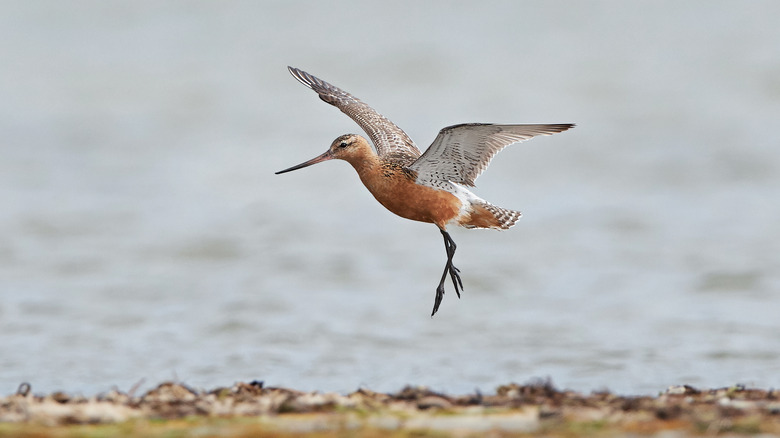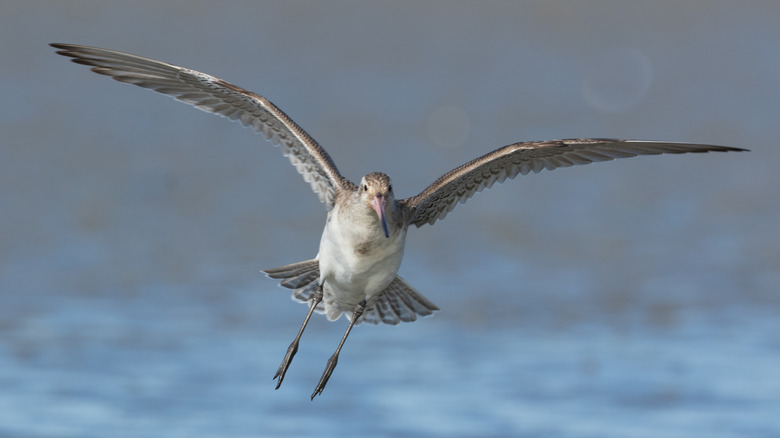The Bird That Can Travel Over 7,000 Miles Without Rest
Birds come equipped with a superpower that humans can only dream about — flying. Being able to fly means being able to get around quickly, and some birds, like geese, are known for migrations for up to 1,500 miles in 24 hours, per National Geographic. While that's an impressive feat, there are some birds who travel much longer distances. Take for instance the albatross, which can travel thousands of miles in one trip over the ocean. Live Science reports that with the aid of the wind, the albatross can glide effortlessly for miles.
While that's impressive, another bird, the bar-tailed godwit, accomplishes more. This relatively small shorebird with an unusually long beak has the distinct honor of making the longest flight ever recorded per Audubon. Godwits are known to travel more than 7,000 miles nonstop. Even more impressive is the fact that godwits are active flyers, meaning their wings are moving throughout their entire flight, unlike the albatross.
Godwits fly incredible lengths every year
Some godwit species are known for traveling from Australia to New Siberia while others migrate from New Zealand to Alaska. Experts have been tagging and tracking the birds since 2007, and they have discovered that they travel upwards of 7,000 miles regularly. These shorebirds live along fertile coastlines in the spring, where they find plenty of food among the beaches and bogs. They also lay their eggs in grassy nests in the spring months, per Smithsonian.
In June or July, they begin the long journey home, where some stop off at the Americas or northern Africa to feed. Others make a nonstop trip, which can take them to eight days. Audubon Alaska executive director Natalie Dawson told Audubon that these migratory feats were "magic," adding that she finds it hard to believe that the birds can flap their wings 24-hours a day without resting. But there's a lot of science behind the magic of these birds, even if we don't quite understand all of it.
Godwits are specially equipped for long distances
Like most migratory birds, godwits have incredible skills that allow them to navigate. Theunis Piersma, a professor at the University of Groningen in the Netherlands, explains to the Smithsonian that godwits are truly masters at what they do. He said that birds must be good at navigation, keeping time, judging distance, and even predicting the weather to accomplish such long flights. But the most important thing they must do pre-flight is load up on enough fat that will give them the energy to make the long trek.
Christopher Guglielmo, from the University of Western Ontario, told the Smithsonian that godwits have a way to store and utilize fat that is different from many other creatures. He explains that while their bodies burn fat, they are also making carbon dioxide and water, to store in the fat. This "superpower" allows them to survive without drinking any water for days at a time. He also said that godwits defy logic because they should collapse after three or four days of flying nonstop, but they don't.
Biology also play a role in how long godwits can fly
Godwits' bodies and wings are aerodynamic, and their respiratory systems allow them to survive on less oxygen as they soar above sea level where oxygen is thinner than it is on land. Research shows that the size of their pectoral muscles, hearts, and lungs increase to two or three times their normal size before they take flight, while the sizes of their gizzards, livers, guts and kidneys shrink. These changes return to normal after the birds reach their destination (via the Smithsonian). Godwits are also fast with speeds ranging between 29 and 50 miles per hour.
The amazing birds have another ability that some humans probably wish they had — the ability to sleep while they work. While it seems impossible, godwits manage to rest while in flight. The Smithsonian explains that this is because their brains are "unihemispheric," allowing them to experience "slow wave sleep." This means one side of their brain sleeps while the other stays awake, switching sides until they reach their destination.
Magnetism is also important for long flights
Birds use a myriad of tools to help them migrate. Some, like landmarks, stars, and smells, we understand. Others, not so much. Take for instance birds' magnetic sense. Scientists are fairly certain that the earth's magnetism plays a part in how these birds navigate long distances, but they're not completely sure how they do it. Some theorize that godwits have something in their cells or beaks that help them stay on course (via Smithsonian).
Another hypothesis states that birds' eyes are sensitive to the earth's magnetic field through what is called "quantum entanglement" (via Smithsonian). The BBC explains that some scientists believe that a chemical in their eyes is sensitive to the earth's magnetic field, allowing them to somehow "see" it, but as of yet, there is no way to be sure. Whatever is guiding them is amazingly accurate. Piersma told the Smithsonian that it seems the birds have a built-in GPS system that gives them the same geographic information that humans use.
One godwit recently set an amazing record
If the typical 7,000 mile stretches godwits make aren't impressive enough, they are currently breaking records. In September 2021, one special male godwit, tagged 4BBRW, set a record of more than 8,100 miles from Alaska to New South Wales, Australia. He flew for 239 hours straight (almost 10 days!), which makes him the champion when it comes to nonstop flight by any land bird. Incredible as that is, 4BBRW isn't a stranger to these kinds of records, Audubon reports that he broke his own record from 2020 in which he traveled 7,580 miles, per Audubon.
But 4BBRW is not alone in his extraordinary treks. A female godwit, tagged 4BYWW, broke 4BBRW's old record of 7,580 miles in September in 8 days and 12 hours traveling at around 36 miles per hour, according to Radio New Zealand. With achievements like these, bar-tailed godwits are the ultimate marathoners.
